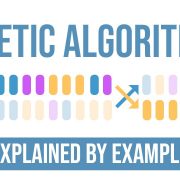Mastering Big O Notation: Understanding Algorithm Efficiency
The efficiency of algorithms is very important in the field of computer science and programming. Consider that there are two different ways to solve a problem; While both may give the correct result, one can take significantly longer to implement than the other. This is where Big O notation steps in, serving as a vital tool for measuring and comparing the efficiency of algorithms. In this article, you can learn to unravel the mystery of Big O notation, its importance, its applications, and how to decipher the cryptic symbols that often accompany it.
The Foundation: What is Big O Notation?
Big O notation is essentially a mathematical concept that provides a way to describe the performance or time complexity of an algorithm. It helps us understand how an algorithm’s runtime grows relative to the size of its input data. In simpler terms, Big O notation answers the question: “How does the runtime of an algorithm change as the input size increases?”
To better grasp this concept, let’s consider a common scenario: searching for an item in an array. For example, a linear search algorithm iterates through array elements one by one until it finds the target element or reaches the end of the array. This type of algorithm is said to have a linear time complexity, denoted as O(n), where ‘n’ represents the size of the input data (in this case, the array).
def linear_search(arr, target):
for element in arr:
if element == target:
return True
return False
However, not all algorithms perform in a linear manner. Some might exhibit more efficient behavior as the input size increases. This is where Big O notation comes into play. It helps programmers make informed decisions about which algorithm to use for a given problem by providing a standardized way to classify algorithms based on their efficiency based on input size.
The Notation: Breaking Down the Symbols
Big O notation is expressed using various symbols and terms that might seem intimidating at first glance. Let’s break down the most common ones:
1. O(1) – Constant Time Complexity:
Algorithms with constant time complexity have a consistent runtime, regardless of the input size. Imagine directly accessing an element from an array using its index. Whether the array contains 10 elements or 1,000, the time taken to access an element remains the same.
def access_element(arr, index):
return arr[index]
2. O(log n) – Logarithmic Time Complexity:
Algorithms with logarithmic time complexity often divide the input data in half with each step. Binary search is a classic example. As the input size increases, the number of steps required to find the target item only increases logarithmically.
def binary_search(arr, target):
low, high = 0, len(arr) - 1
while low <= high:
mid = (low + high) // 2
if arr[mid] == target:
return mid
elif arr[mid] < target:
low = mid + 1
else:
high = mid - 1
return -1
3. O(n) – Linear Time Complexity:
Linear algorithms have a runtime that scales linearly with the input size. As mentioned earlier, a linear search is a prime example. If the input size doubles, the runtime also approximately doubles.
def linear_sum(arr):
total = 0
for element in arr:
total += element
return total
4. O(n log n) – Linearithmic Time Complexity:
Commonly seen in more advanced sorting algorithms like Merge Sort and Quick Sort, this complexity indicates that the algorithm performs slightly worse than linear, but still much better than quadratic algorithms, especially as the input size grows.
def merge_sort(arr):
if len(arr) <= 1:
return arr
mid = len(arr) // 2
left_half = arr[:mid]
right_half = arr[mid:]
left_half = merge_sort(left_half)
right_half = merge_sort(right_half)
return merge(left_half, right_half)
def merge(left, right):
result = []
left_index, right_index = 0, 0
while left_index < len(left) and right_index < len(right):
if left[left_index] < right[right_index]:
result.append(left[left_index])
left_index += 1
else:
result.append(right[right_index])
right_index += 1
result.extend(left[left_index:])
result.extend(right[right_index:])
return result
5. O(n^2) – Quadratic Time Complexity:
Algorithms with quadratic time complexity have runtimes that are proportional to the square of the input size. Nested loops that iterate through an array or matrix are classic examples. If the input size doubles, the runtime quadruples.
def bubble_sort(arr):
n = len(arr)
for i in range(n):
for j in range(0, n - i - 1):
if arr[j] > arr[j + 1]:
arr[j], arr[j + 1] = arr[j + 1], arr[j]
6. O(2^n) – Exponential Time Complexity:
Algorithms with exponential time complexity have runtimes that grow exponentially with the input size. The infamous “brute force” approach to solving problems often falls under this category. As the input size increases, the runtime can quickly become unmanageable.
def fibonacci_recursive(n):
if n <= 1:
return n
return fibonacci_recursive(n - 1) + fibonacci_recursive(n - 2)
7. O(n!) – Factorial Time Complexity:
The slowest of them all, algorithms with factorial time complexity have runtimes that grow at factorial rates with the input size. These are extremely inefficient and are usually avoided whenever possible.
def generate_permutations(elements):
if len(elements) == 1:
return [elements]
permutations = []
for i, element in enumerate(elements):
remaining_elements = elements[:i] + elements[i+1:]
for permutation in generate_permutations(remaining_elements):
permutations.append([element] + permutation)
return permutations
Applying Big O Notation in Real Life
Understanding Big O notation isn’t just an academic exercise—it has practical implications for developers. When faced with different algorithms to solve a problem, programmers can evaluate their efficiency using Big O notation and make informed choices. Choosing an algorithm with a lower time complexity becomes crucial when dealing with large datasets or time-sensitive applications.
Consider a scenario where you need to sort an array. If you have a small array, even an algorithm with quadratic complexity might run relatively quickly. However, as the array size grows, the difference in runtime between a quadratic and a linearithmic algorithm becomes significant. This is where the insight provided by Big O notation can guide your decision-making.
The Hidden Factors: Space Complexity and Real-world Considerations
While Big O notation primarily focuses on time complexity, there’s another dimension to consider: space complexity. Space complexity measures the amount of memory an algorithm uses relative to its input size. An algorithm that requires more memory might not be suitable for devices with limited resources.
Moreover, real-world factors can influence the choice of algorithm beyond theoretical complexity analysis. Programming languages, hardware architectures, and constant factors can all impact an algorithm’s performance. Therefore, it’s important to remember that Big O notation provides a high-level overview of an algorithm’s efficiency and not an absolute guarantee of its runtime.
Conclusion
Big O notation is a powerful tool that helps programmers analyze and compare the efficiency of algorithms. It provides a standardized way to classify algorithms based on their runtime behavior as input size changes. Understanding the symbols and terms associated with Big O notation empowers developers to make informed decisions when choosing algorithms to solve problems. However, it’s essential to remember that while Big O notation offers valuable insights, real-world considerations and practical constraints also play a significant role in algorithm selection. As you continue your journey in computer science and programming, let Big O notation be your guiding light to crafting efficient and optimized solutions.






